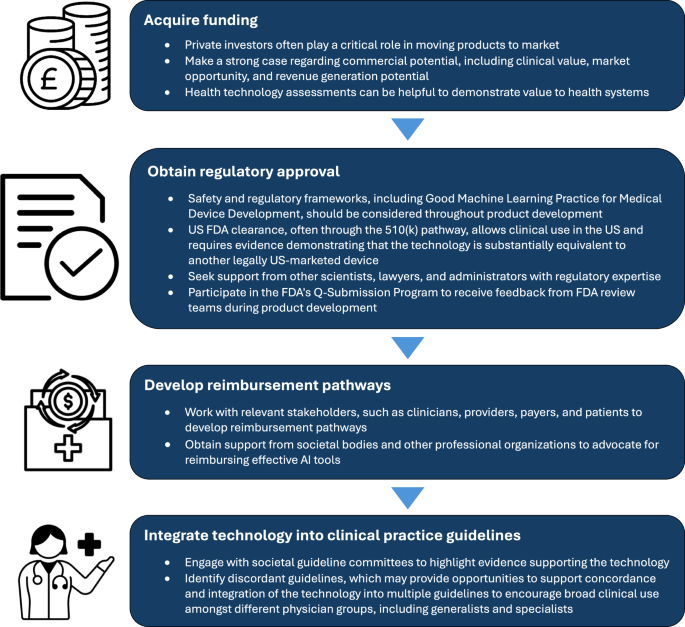AI Insights
Commercialization of medical artificial intelligence technologies: challenges and opportunities

Bajwa, J., Munir, U., Nori, A. & Williams, B. Artificial intelligence in healthcare: transforming the practice of medicine. Future Health. J. 8, e188–e194 (2021).
Lareyre, F. & Raffort, J. Artificial intelligence in vascular diseases: from clinical practice to medical research and education. Angiology https://doi.org/10.1177/00033197251324630 (2025).
Song, P. et al. The global and regional prevalence of abdominal aortic aneurysms: a systematic review and modeling analysis. Ann. Surg. 277, 912–919 (2023).
Eid, M. A. et al. The global burden of peripheral artery disease. J. Vasc. Surg. 77, 1119–1126.e1 (2023).
Sinha, K., Berczeli, M., Lumsden, A. B. & Roy, T. L. Imaging: new frontiers in vascular training. Methodist Debakey Cardiovasc. J. 18, 39–48 (2022).
Zaidan, E. & Ibrahim, I. A. AI governance in a complex and rapidly changing regulatory landscape: a global perspective. Humanit. Soc. Sci. Commun. 11, 1121 (2024).
Mastracci, T. M., Anand, S. S. & Aday, A. W. Peripheral artery disease: a high-risk yet understudied, underdiagnosed, and undertreated condition-a call to action. Can. J. Cardiol. 38, 553–554 (2022).
Chaikof, E. L. et al. The Society for Vascular Surgery practice guidelines on the care of patients with an abdominal aortic aneurysm. J. Vasc. Surg. 67, 2–77.e2 (2018).
Howard, D. P. J. et al. Population‐based study of incidence of acute abdominal aortic aneurysms with projected impact of screening strategy. J. Am. Heart Assoc. 4, e001926 (2015).
Dahl, M., Liisberg, M., Stenehjem, M., Al Obeidi, I. & Sanddal Lindholt, J. Screening for abdominal aortic aneurysms still prevents ruptures: a secondary analysis of the VIVA trial. J. Am. Coll. Cardiol. 84, 2494–2496 (2024).
Anjorin, A. C. et al. Underutilization of guideline-based abdominal aortic aneurysm screening in an Academic Health System. Ann. Vasc. Surg. 83, 184–194 (2022).
Won, D. et al. Sound the alarm: the sonographer shortage is echoing across healthcare. J. Ultrasound Med. 43, 1289–1301 (2024).
Chiu, I.-M. et al. Prospective clinical evaluation of deep learning for ultrasonographic screening of abdominal aortic aneurysms. npj Digit. Med. 7, 1–6 (2024).
Viz.ai | AI-Powered Care Coordination. Viz.ai, the Proven AI-Powered Care Coordination Platform https://www.viz.ai/.
How Viz.ai hit $48.8M revenue with a 325 person team in 2024. Latka https://getlatka.com/companies/viz.ai.
Publications Archive. Viz.ai, the Proven AI-Powered Care Coordination Platform https://www.viz.ai/publications.
Pirahanchi, Y. et al. PFO‐ACCESS: Augmenting Communications for Medical Care or Closure in the Evaluation of Patients With Stroke With Cardiac Shunts. Stroke.: Vasc. Interv. Neurol. 5, e001707 (2025).
Colasurdo, M. et al. Estimation of ventricular and intracranial hemorrhage volumes and midline shift on an external validation data set using a convolutional neural network algorithm. Neurosurgery https://doi.org/10.1227/neu.0000000000003455 (2022).
Figurelle, M. E. et al. Viz.ai implementation of stroke augmented intelligence and communications platform to improve indicators and outcomes for a comprehensive stroke center and network. AJNR Am. J. Neuroradiol. 44, 47–53 (2023).
Karamchandani, R. R. et al. Automated detection of intracranial large vessel occlusions using Viz.ai software: Experience in a large, integrated stroke network. Brain Behav. 13, e2808 (2023).
Viz.ai Strengthens Information Security with ISO-27001:2022 Certification. Viz.ai, the Proven AI-Powered Care Coordination Platform https://www.viz.ai/news/viz-ai-strengthens-information-security-with-iso-certification.
van Leeuwen, K. G. et al. Cost-effectiveness of artificial intelligence aided vessel occlusion detection in acute stroke: an early health technology assessment. Insights Imaging 12, 133 (2021).
Viz.ai revenue, valuation & growth rate. https://sacra.com/c/viz-ai/.
FDA approves stroke-detecting AI software. Nat. Biotechnol. 36, 290–290 (2018).
Hassan, A. E. New technology add-on payment (NTAP) for Viz LVO: a win for stroke care. J. Neurointerv. Surg. 13, 406–408 (2021).
Chen, M. M., Golding, L. P. & Nicola, G. N. Who will pay for AI? Radiol. Artif. Intell. 3, e210030 (2021).
Parikh, R. B. & Helmchen, L. A. Paying for artificial intelligence in medicine. NPJ Digit. Med. 5, 63 (2022).
Abràmoff, M. D. et al. A reimbursement framework for artificial intelligence in healthcare. NPJ Digit. Med. 5, 72 (2022).
US Food & Drug Administration. Artificial Intelligence and Machine Learning (AI/ML)-Enabled Medical Devices. https://www.fda.gov/medical-devices/software-medical-device-samd/artificial-intelligence-and-machine-learning-aiml-enabled-medical-devices (2025).
Muralidharan, V. et al. A scoping review of reporting gaps in FDA-approved AI medical devices. npj Digit. Med. 7, 1–9 (2024).
Wu, K. et al. Characterizing the clinical adoption of medical AI devices through U.S. Insurance Claims. NEJM AI 1, AIoa2300030 (2024).
Thomas, R. & Chalkidou, K. Cost–effectiveness analysis. In Health system efficiency: How to make measurement matter for policy and management [Internet] (European Observatory on Health Systems and Policies, 2016).
Li, X., Zhao, G., Zhang, J., Duan, Z. & Xin, S. Prevalence and trends of the abdominal aortic aneurysms epidemic in general population–a meta-analysis. PLoS ONE 8, e81260 (2013).
Monaco, L. et al. The complexity of funding rare disease research: an IRDiRC assessment of the landscape. rdodj 3, 27 (2024).
Vervoort, D. et al. One-time screening for abdominal aortic aneurysm in Ontario, Canada: a model-based cost-utility analysis. Can. Med. Assoc. J. 196, E112–E120 (2024).
National Academies of Sciences, E., Division, H. and M., Health, B. on G. & States, C. on G. H. and the F. of the U. Promoting Cardiovascular Health and Preventing Cancer. in Global Health and the Future Role of the United States (National Academies Press (US), 2017).
Nishimiya, K., Matsumoto, Y. & Shimokawa, H. Recent advances in vascular imaging. Arterioscler. Thromb. Vasc. Biol. 40, e313–e321 (2020).
Trowman, R., Migliore, A. & Ollendorf, D. A. The value and impact of health technology assessment: discussions and recommendations from the 2023 Health Technology Assessment International Global Policy Forum. Int. J. Technol. Assess. Health Care 39, e75 (2023).
US Food & Drug Administration. Good Machine Learning Practice for Medical Device Development: Guiding Principles (2025).
Lottes, A. E. et al. Navigating the regulatory pathway for medical devices—a conversation with the FDA, clinicians, researchers, and industry experts. J. Cardiovasc. Transl. Res. 15, 927–943 (2022).
Office of the Commissioner (2025) U.S. Food and Drug Administration. FDA https://www.fda.gov/.
Dhruva, S. S., Darrow, J. J., Kesselheim, A. S. & Redberg, R. F. Experts’ views on FDA regulatory standards for drug and high-risk medical devices: implications for patient care. J. Gen. Intern. Med. 37, 4176–4182 (2022).
Jhawar, N. et al. Impact of professional society guideline publications in medicine subspecialties from 2012 to 2022: implications for clinical care and health policy. Mayo Clin. Proc. Innov. Qual. Outcomes 7, 262–266 (2023).
US Preventive Services Task Force. et al. Screening for abdominal aortic aneurysm: US Preventive Services Task Force Recommendation Statement. J. Am. Med. Assoc. 322, 2211–2218 (2019).
Ahmed, M. I. et al. A systematic review of the barriers to the implementation of artificial intelligence in healthcare. Cureus 15, e46454 (2023).
AI Insights
A Neural-Network-Based Approach to Smarter DPD Engines – Electronic Design
AI Insights
Albania appoints AI bot ‘minister’ to fight corruption in world first | Corruption News

Sceptics wonder whether ‘Diella’, depicted as a woman in traditional folk costume, will herself be ‘corrupted’.
Published On 12 Sep 2025
Albanian Prime Minister Edi Rama has put an artificial intelligence-generated “minister” in charge of tackling corruption in his new cabinet.
Diella, which means “sun” in Albanian, was appointed on Thursday, with the leader introducing her as a “member of the cabinet who is not present physically” who will ensure that “public tenders will be 100 percent free of corruption”.
Recommended Stories
list of 3 itemsend of list
The awarding of tenders has long been a source of corruption in the Balkan country of 2.8 million people, which aspires to join the European Union.
Corruption is a key factor in Albania’s bid to join the bloc.
Rama’s Socialist Party, which recently secured a fourth term in office, has said it can deliver EU membership for Albania in five years, with negotiations concluding by 2027.
Lawmakers will soon vote on Rama’s new cabinet, but it was unclear whether he would ask for a vote on Diella’s virtual post.
Legal experts say more work may be needed to establish the official status of Diella, who is depicted on screen as a woman in a traditional Albanian folk costume.
Gazmend Bardhi, parliamentary group leader of the Democrats, said he considered Diella’s ministerial status unconstitutional.
“[The] Prime Minister’s buffoonery cannot be turned into legal acts of the Albanian state,” Bardhi posted on Facebook.
The prime minister did not provide details of what human oversight there might be for Diella, or address risks that someone could manipulate the artificial intelligence bot.
Launched earlier this year as a virtual assistant on the e-Albania public service platform, Diella helped users navigate the site and get access to about one million digital documents.
So far, she has helped issue 36,600 digital documents and provided nearly 1,000 services through the platform, according to official figures.
Not everyone is convinced.
One Facebook user said, “Even Diella will be corrupted in Albania.”
Another said, “Stealing will continue and Diella will be blamed.”
AI Insights
The AI Ascension: How Artificial Intelligence is Reshaping the 2025 Global Market Landscape – FinancialContent
-

 Business2 weeks ago
Business2 weeks agoThe Guardian view on Trump and the Fed: independence is no substitute for accountability | Editorial
-
Tools & Platforms1 month ago
Building Trust in Military AI Starts with Opening the Black Box – War on the Rocks
-

 Ethics & Policy2 months ago
Ethics & Policy2 months agoSDAIA Supports Saudi Arabia’s Leadership in Shaping Global AI Ethics, Policy, and Research – وكالة الأنباء السعودية
-

 Events & Conferences4 months ago
Events & Conferences4 months agoJourney to 1000 models: Scaling Instagram’s recommendation system
-

 Jobs & Careers2 months ago
Jobs & Careers2 months agoMumbai-based Perplexity Alternative Has 60k+ Users Without Funding
-

 Podcasts & Talks2 months ago
Podcasts & Talks2 months agoHappy 4th of July! 🎆 Made with Veo 3 in Gemini
-

 Education2 months ago
Education2 months agoMacron says UK and France have duty to tackle illegal migration ‘with humanity, solidarity and firmness’ – UK politics live | Politics
-

 Education2 months ago
Education2 months agoVEX Robotics launches AI-powered classroom robotics system
-

 Funding & Business2 months ago
Funding & Business2 months agoKayak and Expedia race to build AI travel agents that turn social posts into itineraries
-

 Podcasts & Talks2 months ago
Podcasts & Talks2 months agoOpenAI 🤝 @teamganassi























